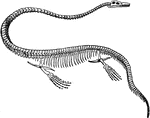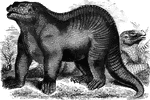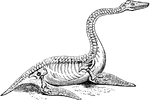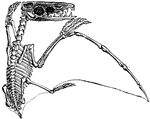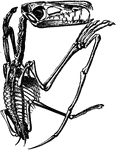Dinosaurs
The Dinosaurs ClipArt gallery includes 37 illustrations dinosaurs and other prehistoric animals. Please note that many of these illustrations come from nineteenth century sources and therefore may not reflect contemporary scientific understanding of these creatures.
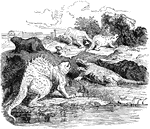
Ancient Animals
This is an illustration of the smaller animals from the time when Dinosaurs ruled the planet.
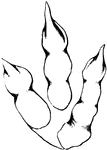
Brontozoum Giganteum
This illustration shows the track of a Brontozoum Giganteum. The trac is actually eighteen inches long,…
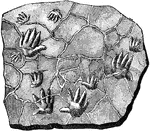
Chirotherium Tracks
Tracks of Chirotherium or "hand-beast" in Buntsandstein found in Hessbeg, Germany.

Chirotherium Tracks
An illustration of a fossil containing Chirotherium tracks. Chirotherium (also known as Cheirotherium)…
Diplodocus
An illustration of a Diplodocus skeleton and the caudal vertebrae (A and B). Diplodocus is a genus of…

Glyptodon
"Glyptodon (Glyptodon clavipes). The typical and best-known genus of the family Glyptodontidae; the…

Hylaeosaurus
The hylaeosaurus measured between twenty and thirty feet in length, and fed on vegetation.
Archaeopteryx Skeleton
An illustration of an Ichthyosaurus skeleton. Ichthyosaurus is an extinct genus of ichthyosaur from…

Ichthyosaurus Skull
An illustration of an Ichthyosaurus skull. Ichthyosaurus is an extinct genus of ichthyosaur from the…

Iguanodon
An extinct fossil colossal lizard found in the Wealden strata; so called from the resemblance of its…
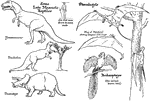
Late Mesozoic Age Reptiles
Some Late Mesozoic reptiles. Shown are the Tyrannosaurus, Trachodon, Triceratops, Pterodactyls, and…
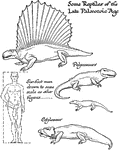
Reptiles of the late Paleozoic age
Some reptiles of the Late Paleozoic Age. The six-foot man is drawn to the same scale as the other animals.
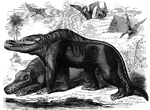
Megalosaurus and pterodactyls
A pair of megalosauruses, with a group of pterodactyls in the background.

Megatherium Skeleton
Megatherium ("Great Beast") was a genus of elephant-sized ground sloths that lived from two million…
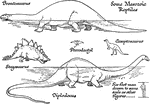
Mesozoic Age Reptiles
Some Mesozoic reptiles. Shown are the Brontosaurus, Stegosaurus, Pterodactyl, Camptosaurus, and the…

Mosasaurus Jaw
The jaw bones of the Mosasaurus, a great snake-like reptile of the Cretaceous Period.
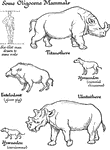
Mammals from the Oligocene Mammals
Mammals from the Oligocene age. Shown are the Titanothere, Entelodont, Hyracodon, Uintathere, and the…

Pterodactyl
"A genus of extinct flying reptiles of the order Pterosauria, found in the Jura Limestone formation,…
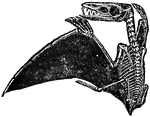
Pterodactyl
A remarkable genus of fossil lizards, peculiar to the Mesozoic strata. Its anomalous structure was long…
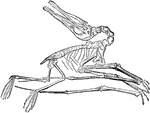
Pterodactyl
A remarkable genus of fossil lizards, peculiar to the Mesozoic strata. Its anomalous structure was long…
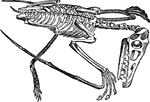
Pterodactyle skeleton
"So peculiar and strange is the structure of these animals, that the first specimen discovered was classed…
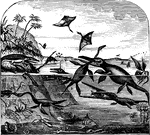
Reptiles
In this age the animals and plants begin to resemble existing species. The age is characterized mainly…

Megalosaurus Skull
An illustration of the skull of a megalosaurus. Megalosaurus is a genus of large meat-eating theropod…


